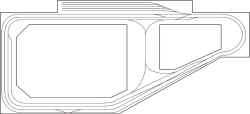
N-Scale Layout
"Exploded N-Scale Engine Views"
Retired
(click on image for a full display)
Revision 1
The train room was 120" x 94". This layout was an around the wall setup.
designed for running long intermodal traffic.
Not much space was allocated for switching areas but much for storage of long trains.
Motive power - View this page
This layout has been retired. Below you'll find the details of the retired layout.
The Framework - This layout was built using five
modules. The total layout is 16' x 3 1/2'. Each module's frame was constructed from 1x2's
with 2x2's for legs. The modules are bolted together, using three 2" machine screws.
The surface is 3/8" particleboard. Risers were created to provide elevation leading
from flat land into the tunnel.
Link to the Aztec
Track Cleaning cars
The Roadbed - N-scale cork was used. The cork
was attached to the surface using a mixture of yellow glue and water. To get a good bond,
I used a can of dog food and rolled it along the surface of the cork.
Signals - I am using Sunrise
signals
(see below) to
indicate turnout position in some locations. In use are three single head and two double
head signals. Peco accessory switches are attached to the switch machines to provide
current to the LEDs to indicate turnout position. I have also installed a few "Signal
Animators" and a Jay's signal (see below) from Logic Rail. It's a quick way to change aspects, indicating red,
green and yellow. As the engine passes the signal, it turns from green to red.
When the last car has passed and after a delay, a red indication becomes yellow. Then
after another delay, it becomes a flashing yellow, then green again.
The Electrical side - DCC was not considered because I
viewed DCC as a mysterious beast. I was able to obtain a used Digitrax Big Boy from a
friend, Frank Kenny. After I got over the fear of DCC, I installed it using my two MRC
Tech II power packs.
The first power pack was used to provide power to a separate power supply for the Peco
turnout machines. It also provided input power to an adjustable power supply for the
Sunrise signals. The second power pack was solely used to power the Big Boy.
In my junk cabinet, I found a 30A 13.6VDC power supply. I used this to recharge nicads for
R/C cars. I replaced the power pack for the Digitrax Big Boy (BB), only to find the decoded engines
would not power up. It was then moved to replace the first power pack, only to find it
would not provide enough volts to throw the switch machines. I received some good input
from the N-scale list and contacted Loy's Toys. He provided a power supply (p/s) kit with
enough volts to run the BB. The 30A p/s was pulled and replaced with one of the original
p/s. I now have two of Loy's power supplies, one for DCC and the other to
provide auxiliary power. After some thought, I have upgraded my BB to a Digitrax
Chief.
The Track work - The track was attached to the
cork using the yellow glue/water mixture. Instead of rolling the dog food can, I placed
them on the track as weights until the glue setup. Peco code 80 flex track was used
exclusively. All rail joiners are soldered to provide power flow. Numerous power feeders
are installed throughout the layout. The turnouts installed are Peco standard, no electro
frogs. I was experiencing a power drop after crossing a turnout. To correct this
situation, I installed power feeders immediately before and after the turnout. The problem
was solved.
Track cleaning - I use two methods to clean the
rails. The first method utilizes an Aztec car with the new and improved wet-roller with
Goo Gone, followed by an Aztec car using a wet-roller with 409. The leading Aztec car lays
down the Goo Gone and the trailing wet-roller w/409 picks it up. Method two consists of
two Aztecs behind the engines. The first car runs just an Aztec wet-roller and the second
has a wet-roller with the wet-mop system and a magnet. In the later configuration, both
rollers are dry and only the mops are wet. My Aztecs run daily.
Scenery - Styrofoam blocks were used to
provide a base for the tunnel and hills. I tried the hydrocal and paper towel method, then
the plaster cloth method, all of which was messy. Finally, the blocks were covered with
Sculpta-mold. I mixed it with small amounts of water. This method allowed ample work time
and dried to a desirable texture without having to carve landscape. The highway was
created using Polyterrain mud. The trees and foliage are by Woodland Scenics.
The Rolling stock - I run mostly container freight
on deluxe Innovation double stacks, Alan Curtis' spine cars, Walters' well cars, Con-Cor fuel foilers, Roundhouse Husky
Stacks and converted Atlas front-runners on the Union Pacific main. The headend
power units are C44-9W's, SD45's, a C44-9W distributed power unit
in the middle and a C44-8W helper on the end. On the BNSF main, I run a unit
J-A coalgon train, headed by C44-9W's with U25 helpers. The other rolling stock includes Atlas, E&C
Shops, MTL, Con-Cor and other freight cars.
Structures - I have a Walthers Grain
Elevator, Service Track Structures, 2-Stall Engine House, Water Street Freight Terminal, a
Rix grain elevator, a Hardwood Furniture Company, a Con-Cor Electrical Substation and
other structures. The downtown area is under construction. The detail items include
Preiser's figures, Showcase Miniatures vehicles, GHQ vehicles and many other vendors.
Work in process includes adding Sunrise LED
parking lot lites in the Grain Elevator and Power Station area.